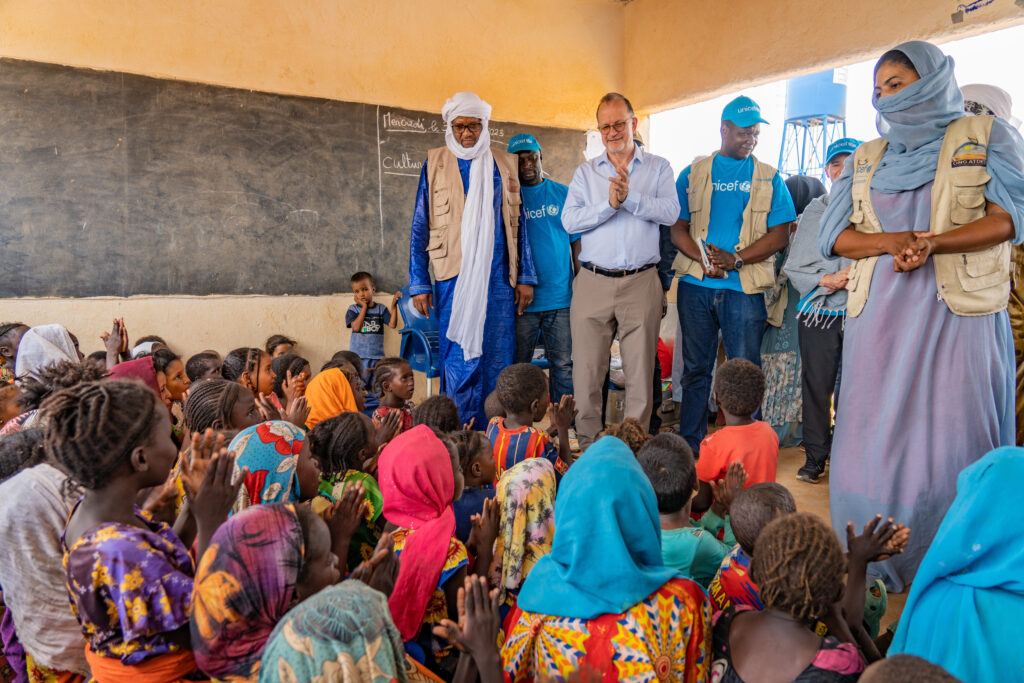
A combination of protracted armed conflict, internal displacement, and restricted humanitarian access risks pushing nearly one million children under the age of 5 in Mali into acute malnutrition by December 2023 – with at least 200,000 at risk of dying of hunger if life-saving aid fails to reach them.
Almost a quarter of Mali’s population suffers from moderate or acute food insecurity. Meanwhile, for the first time ever in the country, over 2,500 people are at risk of famine in the crisis-affected region of Menaka, many of them children.
The warning comes as senior humanitarian officials from UNICEF and the United Nations World Food Programme (WFP) visited the country this week to reiterate the support from both agencies to Mali’s people, in cooperation with local authorities and humanitarian counterparts.
“Mali is going through a complex humanitarian crisis and needs urgent support to avert a disaster for children, who are again paying the highest price for a crisis not of their making,” said Ted Chaiban, UNICEF Deputy Executive Director for Humanitarian Action, and Supply Operations.
“UNICEF, WFP and partners have been present on the ground during some of Mali’s hardest years and we will continue to work on humanitarian and development issues for as long as our services are needed.”
In total, close to five million children are in urgent need of humanitarian assistance in Mali, including health, nutrition, education, and protection services – as well as access to safe water. The number shows an increase of at least 1.5 million children in need since 2020.
“It is of the utmost importance that we ensure the humanitarian crisis in Mali has the attention it needs. At a time when the world is in turmoil, we do not have the right to choose who to save.
”But we do have a duty to work together to save and change lives,” said Carl Skau, WFP’s Deputy Executive Director and Chief Operating Officer.
“We must do what we can to help vulnerable families, especially children and women, by working closely with our partners to prevent famine, tackle acute food insecurity and malnutrition head-on and strengthen their resilience.”
In addition to violence and conflict, climate shocks in some parts of the country have led to massive displacement in the last few months. As of 30 June 2023, over 377,000 people have been forced to flee their homes, more than half of them children.
According to the latest estimates, at least 1.6 million children are in urgent need of protection in Mali.
In 2022, the United Nations verified 1,024 grave violations against children in the country, including recruitment and use by armed forces and armed groups, killing and maiming. Conflict and lack of resources have also forced more than 1,700 schools to close, keeping at least half a million children from accessing education.
Despite the urgent situation, humanitarian appeals for Mali continue to be severely underfunded. So far in 2023, just 21 per cent of the US $751.4 million required by the United Nations has been raised, while less than one-third of the 2023 UNICEF Humanitarian Appeal for Children in Mali is currently funded – US$ 8.5 million received in the first half of the year.
UNICEF and WFP urgently need US $184.4 million to reach 8.8 million people in 2023, including 4.7 million children.
Funding will be essential to provide emergency food assistance to vulnerable people and support medical services, including fuel to keep vaccines cold and to buy more humanitarian supplies such as life-saving treatments for children with malnutrition.
The plight of children and families in Mali is part of a wider regional emergency in the central Sahel, which also includes Burkina Faso and Niger.
Despite these ongoing crises, humanitarian workers and supplies need to safely reach the most vulnerable children and families where urgently needed. Any disruptions or delays in aid delivery will have a negative impact on the survival of children and their families.

